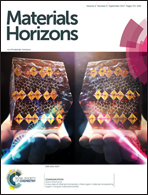Solution-processable, crystalline material for quantitative singlet fission†
Abstract
Amorphous nanoparticles of the singlet fission chromophore 6,13-bis(triisopropylsilylethynyl)pentacene (TIPS-Pn) are fully crystallized through co-precipitation with a chemical additive. Time-resolved measurements indicate that singlet fission in the crystalline nanoparticles is quantitative, or lossless, whereas losses are evident in the amorphous nanoparticles as a result of frustrated triplet pair separation. Because triplet pairs form rapidly and separate slowly in amorphous material, mixed-phase samples are unable to compensate for these losses.

- This article is part of the themed collection: 7th EuCheMS Chemistry Congress – Molecular frontiers and global challenges


 Please wait while we load your content...
Please wait while we load your content...